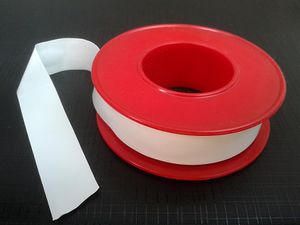Difference between revisions of "Pentane"
(Created page with "PTFE seal tape. '''Polytetrafluoroethylene''' or '''PTFE''' or '''Teflon''' is a synthetic fluoropolymer of tetrafluoroethylene,...") |
|||
| Line 1: | Line 1: | ||
[[File:PTFE_thread_seal_tape.jpg|thumb|300px|PTFE seal tape.]] | [[File:PTFE_thread_seal_tape.jpg|thumb|300px|PTFE seal tape.]] | ||
| − | ''' | + | '''Pentane''' is an organic compound, an alkane with 5 carbon atoms. It is composed of three isomers, '''n-pentane''', [[isopentane]] (or methylbutane) and [[neopentane]]. While the term "pentane" may refer to any of the isomers, the IUPAC nomenclature specifies that the term must only be used for the n isomer. |
==Properties== | ==Properties== | ||
===Chemical=== | ===Chemical=== | ||
| − | + | Pentane, like other hydrocarbons, will burn in air when ignited by an open flame to release carbon dioxide and water vapor. | |
===Physical=== | ===Physical=== | ||
| − | + | Pentane is a colorless liquid hydrocarbon, with a characteristic smell. It is insoluble in water, but miscible with other organic solvents. It has a density of 0.621 g/cm<sup>3</sup>, meaning it's lighter than water. It boils at 36°C and melts at -130°C. | |
==Availability== | ==Availability== | ||
| − | + | Pentane can be purchased form chemical suppliers. Certain pesticides contain pentane. | |
==Preparation== | ==Preparation== | ||
| − | + | Pentane can be prepared by reducing pentane derivates. | |
==Projects== | ==Projects== | ||
| − | * | + | *Extraction (solvent) |
| − | * | + | *Phthalic and maleic anhydride synthesis |
==Handling== | ==Handling== | ||
===Safety=== | ===Safety=== | ||
| − | + | Pentane evaporates very fast and the vapors are hazardous if inhaled, work should be performed in a fumehood or outside. If pentane is inhaled in large amounts, further exposure should be limited and one should seek fresh air. | |
===Storage=== | ===Storage=== | ||
| − | + | Due to its low boiling point, pentane should be stored in closed glass bottles, at constant temperature, away from any source of heat, even small ones. If it's stored at low temperatures, and then brought at room temperatures or slightly higher, pressure will build up in the bottle from the vapors and the bottle can explode. It is mandatory to open the bottle from time to time, to release the pressure. | |
| + | |||
| + | Commercial pentane contains small amounts of inhibitors, that prevent its degradation, over long periods of time. They can be removed by distillation, as their boiling point is much higher than that of pentane. | ||
===Disposal=== | ===Disposal=== | ||
| − | + | Pentane can be safely burned, as it theoretically should not generate any toxic byproducts. However, like other hydrocarbons, carbon monoxide can be formed so this should not be performed indoors. | |
==References== | ==References== | ||
<references/> | <references/> | ||
===Relevant Sciencemadness threads=== | ===Relevant Sciencemadness threads=== | ||
Revision as of 15:37, 16 June 2015
Pentane is an organic compound, an alkane with 5 carbon atoms. It is composed of three isomers, n-pentane, isopentane (or methylbutane) and neopentane. While the term "pentane" may refer to any of the isomers, the IUPAC nomenclature specifies that the term must only be used for the n isomer.
Contents
Properties
Chemical
Pentane, like other hydrocarbons, will burn in air when ignited by an open flame to release carbon dioxide and water vapor.
Physical
Pentane is a colorless liquid hydrocarbon, with a characteristic smell. It is insoluble in water, but miscible with other organic solvents. It has a density of 0.621 g/cm3, meaning it's lighter than water. It boils at 36°C and melts at -130°C.
Availability
Pentane can be purchased form chemical suppliers. Certain pesticides contain pentane.
Preparation
Pentane can be prepared by reducing pentane derivates.
Projects
- Extraction (solvent)
- Phthalic and maleic anhydride synthesis
Handling
Safety
Pentane evaporates very fast and the vapors are hazardous if inhaled, work should be performed in a fumehood or outside. If pentane is inhaled in large amounts, further exposure should be limited and one should seek fresh air.
Storage
Due to its low boiling point, pentane should be stored in closed glass bottles, at constant temperature, away from any source of heat, even small ones. If it's stored at low temperatures, and then brought at room temperatures or slightly higher, pressure will build up in the bottle from the vapors and the bottle can explode. It is mandatory to open the bottle from time to time, to release the pressure.
Commercial pentane contains small amounts of inhibitors, that prevent its degradation, over long periods of time. They can be removed by distillation, as their boiling point is much higher than that of pentane.
Disposal
Pentane can be safely burned, as it theoretically should not generate any toxic byproducts. However, like other hydrocarbons, carbon monoxide can be formed so this should not be performed indoors.
